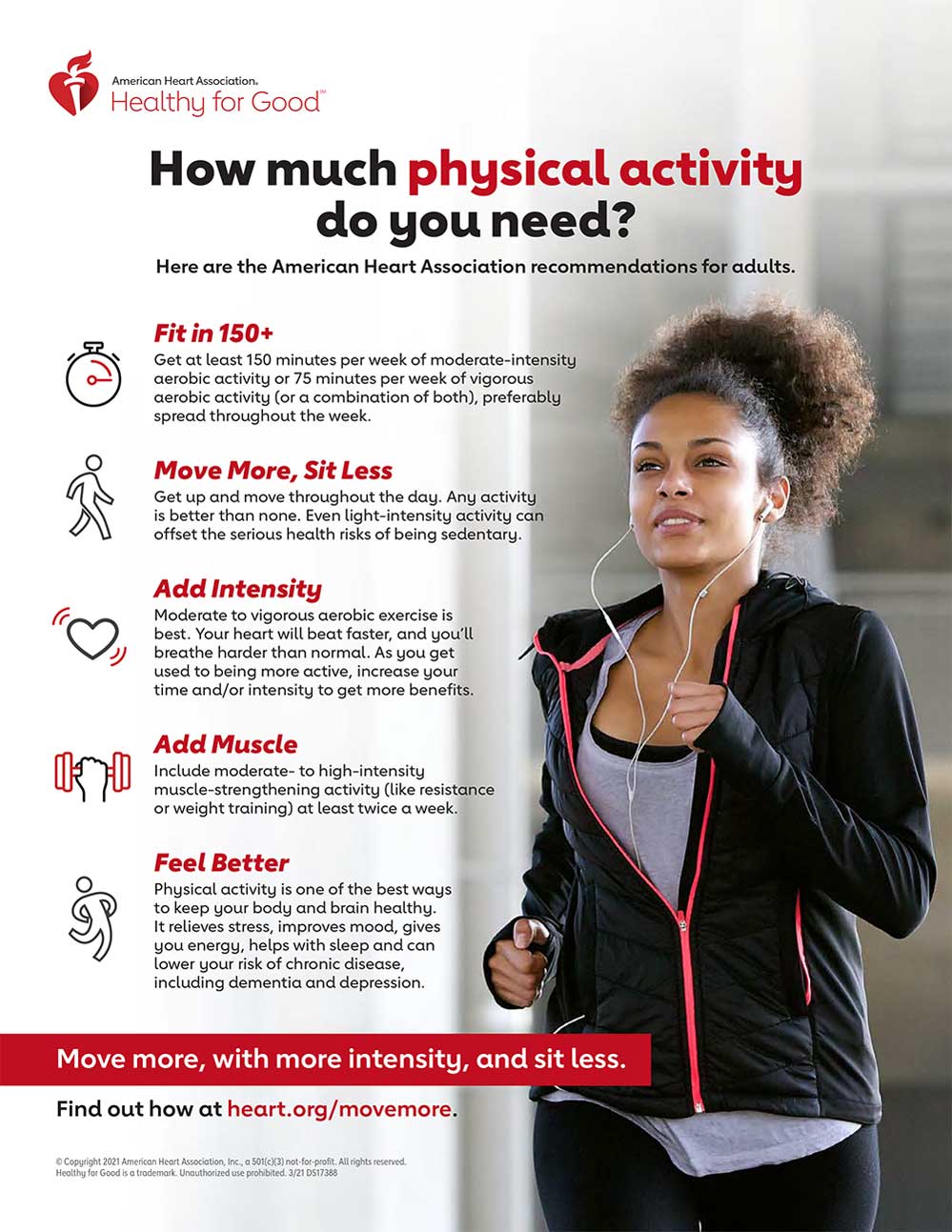American Heart Association Recommendations for Physical Activity in Adults and Kids
Are you fitting in at least 150 minutes (2.5 hours) of heart-pumping physical activity per week? If not, you’re not alone. Only about one in five adults and teens get enough exercise to maintain good health. Being more active can help all people think, feel and sleep better and perform daily tasks more easily. And if you’re sedentary, sitting less is a great place to start.
These recommendations are based on the Physical Activity Guidelines for Americans, 2nd edition, published by the U.S. Department of Health and Human Services, Office of Disease Prevention and Health Promotion. They recommend how much physical activity we need to be healthy. The guidelines are based on current scientific evidence supporting the connections between physical activity, overall health and well-being, disease prevention and quality of life.
 Recommendations for Adults
Recommendations for Adults
- Get at least 150 minutes per week of moderate-intensity aerobic activity or 75 minutes per week of vigorous aerobic activity, or a combination of both, preferably spread throughout the week.
- Add moderate- to high-intensity muscle-strengthening activity (such as resistance or weights) on at least 2 days per week.
- Spend less time sitting. Even light-intensity activity can offset some of the risks of being sedentary.
- Gain even more benefits by being active at least 300 minutes (5 hours) per week.
- Increase amount and intensity gradually over time.
Recommendations for Kids
- Children 3-5 years old should be physically active and have plenty of opportunities to move throughout the day.
- Kids 6-17 years old should get at least 60 minutes per day of moderate- to vigorous-intensity physical activity, mostly aerobic.
- Include vigorous-intensity activity on at least 3 days per week.
- Include muscle- and bone-strengthening (weight-bearing) activities on at least 3 days per week.
- Increase amount and intensity gradually over time.
A Little Means A Lot
What is intensity?
Physical activity is anything that moves your body and burns calories. This includes things like walking, climbing stairs and stretching.
Aerobic (or “cardio”) activity gets your heart rate up and benefits your heart by improving cardiorespiratory fitness. When done at moderate intensity, your heart will beat faster and you’ll breathe harder than normal, but you’ll still be able to talk. Think of it as a medium or moderate amount of effort.
Examples of moderate-intensity aerobic activities:
- brisk walking (at least 2.5 miles per hour)
- water aerobics
- dancing (ballroom or social)
- gardening
- tennis (doubles)
- biking slower than 10 miles per hour
Vigorous intensity activities will push your body a little further. They will require a higher amount of effort. You’ll probably get warm and begin to sweat. You won’t be able to talk much without getting out of breath.
Examples of vigorous-intensity aerobic activities:
- hiking uphill or with a heavy backpack
- running
- swimming laps
- vigorous aerobic dancing
- heavy yardwork such as continuous digging or hoeing
- tennis (singles)
- cycling 10 miles per hour or faster
- jumping rope
Knowing your target heart rate can also help you track the intensity of your activities.
For maximum benefits, include both moderate- and vigorous-intensity activity in your routine along with strengthening and stretching exercises.
What if I’m just starting to get active?
Don’t worry if you can’t reach 150 minutes per week just yet. Everyone has to start somewhere. Even if you've been sedentary for years, today is the day you can begin to make healthy changes in your life. Set a reachable goal for today. You can work toward the recommended amount by increasing your time as you get stronger. Don't let all-or-nothing thinking keep you from doing what you can every day.
The simplest way to get moving and improve your health is to start walking. It's free, easy and can be done just about anywhere, even in place.
Any amount of movement is better than none. And you can break it up into short bouts of activity throughout the day. Taking a brisk walk for five or ten minutes a few times a day will add up.
If you have a chronic condition or disability, talk with your healthcare provider about what types and amounts of physical activity are right for you before making too many changes. But don’t wait! Get started today by simply sitting less and moving more, whatever that looks like for you.
The takeaway: Move more, with more intensity, and sit less.
Science has linked being inactive and sitting too much with higher risk of heart disease, type 2 diabetes, colon and lung cancers, and early death.
It’s clear that being more active benefits everyone and helps us live longer, healthier lives.
Here are some of the big wins:
- Lower risk of heart disease, stroke, type 2 diabetes, high blood pressure, dementia and Alzheimer’s, several types of cancer, and some complications of pregnancy
- Better sleep, including improvements in insomnia and obstructive sleep apnea
- Improved cognition, including memory, attention and processing speed
- Less weight gain, obesity and related chronic health conditions
- Better bone health and balance, with less risk of injury from falls
- Fewer symptoms of depression and anxiety
- Better quality of life and sense of overall well-being
So what are you waiting for? Let’s get moving!
Share an infographic of the Physical Activity Recommendations for Adults and the Physical Activity Recommendations for Kids





